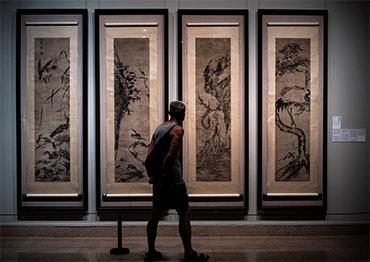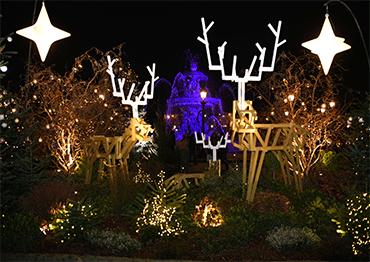n the animation blockbuster Nezha 2, which premiered in January and broke box office records, an unexpected character sparked criticism.
The Deer Boy, clad in elegant white and gold robes, commands the demon-hunting forces with the air of a heroic, celestial knight. However, he reveals a darker side, turning out to be more ruthless than the demons he chases.
Many viewers took to social media to express their disapproval, condemning his lack of empathy and his support of evil, placing the Deer Boy among the film’s most disliked characters.
Traditionally, deer symbolize longevity, agility and prosperity in Chinese culture. Like in the film, a deer serves as the assistant and mount of the Longevity God of the South Pole from Daoist belief.
Similarly, deer have appeared in mythologies across Europe. Artemis, the Greek goddess of the wilderness, treasured the stags of the forests and sought retribution against those who hunted them. In Celtic religion, deer are a symbol associated with Cernunnos, a god of nature, wild beasts and fertility. For centuries, deer hunting was a pastime associated with nobility and aristocracy in northern Europe, reflected in the animal’s inclusion in hundreds of family crests and coats of arms.
More recently, Santa Claus is famously depicted riding in a sleigh pulled by nine reindeer – the most beloved being Rudolf, an image originating in the 1823 poem “A Visit from St. Nicholas” (also known as “The Night Before Christmas”).
Is it just coincidence that deer play such prominent roles in both Chinese and Western cultures? What symbolic meaning do they carry? In an interview with China News Service, Li Qian, a writer and folk art expert, offers a multidimensional comparison of deer imagery in China and the West.
CNS: Are the deer associated with the Chinese longevity god and Santa Claus in Western culture the same? Why are deer seen as sacred and spiritual animals in both traditions?
Li Qian: This is an interesting cultural phenomenon. The God of Longevity rides a white-lipped deer, while the ones pulling Santa Claus’s sleigh are reindeer.
The white-lipped deer (also known as Thorold’s deer) is a treasured animal in China’s western provinces of Gansu, Qinghai, Yunnan and Sichuan, as well as Xizang Autonomous Region, while reindeer are mainly found in the circumpolar regions of the Northern Hemisphere, including Eurasia, North America and some large islands.
Though far apart, they are both among the best-looking species in the deer family. The white-lipped deer stands tall, has a slightly triangular head, long neck, big eyes, long and pointed ears, and a white lower lip and neck, all of which exude a venerable nobility. That’s why it has always been regarded as a sacred deer. Reindeer are also tall, with thick fur that allows them to thrive in cold climates and wide hooves that allow them to run fast in the snow. Male reindeer have large antlers that make them look so strong they seem inviolable.
The God of Longevity is a deity in Daoism, a religion with practices involving the pursuit of immortality. Therefore, the god has an important position in its pantheon. As the mount of the God of Longevity, the deer naturally stands out as a special animal. From a biological point of view, the deer is not only muscular, but also robust and self-healing. The fact that its antlers grow and fall off every year undoubtedly gives it an aura of mystery, thus contributing to its presence in mythology.
The nine reindeer that pull the sleigh for Santa Claus are led by one called Rudolph, whose glowing red nose helps guide the way. Santa Claus is generally considered a figure inspired by St. Nicholas, and reindeer are among the animals closest to people living in the circumpolar North. It is docile, tamable and able to carry loads through the snow and across swamps and forests. In fact, dogs are also sleigh-pulling animals in North America, but as they tend to make a lot of noise, they are not an ideal choice for Santa, who has to be quiet when delivering gifts to children.
CNS: As animals closely linked to human life, how have deer become integrated into both Chinese and Western cultures?
LQ: Since ancient times, Chinese people have adopted deer as totems, performed rituals with deer, enjoyed watching deer, told stories about deer, as well as created written characters and paintings using deer-related elements.
The Remedies for Fifty-two Ailments, unearthed from the Mawangdui Han Tombs [which date back to the 2nd century BCE] in the central Chinese city of Changsha, records the use of burnt deer antlers for treating swelling and pain. Deer hides can be made into clothes for warmth, antlers can be used as decorations, even weapons [like the bows used by Deer Boy]. We can see Chinese people’s deep fondness for deer is also reflected in Chinese characters. The character for “beautiful” in its traditional form (麗) uses the character for deer (鹿) as its lower part. As deer are beautiful and elegant when they run, the character 麗 has positive meanings such as “beautiful” and “gorgeous,” among others.
In the meantime, the Chinese character for deer [鹿, pronounced lu] is also a homophone with (禄) which represents fortune and high political positions. Therefore, the deer is often included in traditional Chinese paintings as a symbol of good wishes. Many ancient painters created works with deer themes.
In North America, the Inuit of Alaska make their large Ulu knives [a curved cutting tool with thousands of years of history] with antler and ivory handles. For the Sami people of northern Norway, the reindeer is the primary basis of their economy and livelihoods. Deer are also present in Western names. For example, Oscar is derived from the Irish Gaelic word os, meaning “deer,” and car, which comes from cara, meaning “friend.” Overall, the deer represents happiness, beauty and power in both China and the West, which is yet another coincidence between Chinese and Western cultures.
CNS: What are the differences in the symbolism of deer in Chinese and Western traditions? What historical or cultural factors have contributed to these differences?
LQ: This answer can be found in Chinese and Western literary works. The famous classic Book of Songs, a collection of poems written from the 11th to 6th centuries BCE, features a piece starting with a line that reads “How gaily call the deer” in describing the relaxing atmosphere of a royal feast. This line was borrowed by Eastern Han politician and general Cao Cao (155-220) in his work “A Short Song” to express his desire to recruit talented people. Many ancient Chinese poems include deer-related expressions in allusion to hermitry, which was viewed as an idyllic and virtuous lifestyle for ancient scholars.
Among more contemporary Chinese literature, I am familiar with several works: In Chen Zhongshi’s White Deer Plain, the white deer, as the guardian of the plain, serves as a sort of divine omen. In Chi Zijian’s Right Bank of the Ergun, the reindeer is the messenger of the gods, guaranteeing the survival of the indigenous reindeer-herding Ewenki people of Inner Mongolia Autonomous Region. Children’s book author Gerelchimeg Blackcrane from Inner Mongolia also celebrates life in his Deer series, which tell stories about children’s friendship with reindeer and moose.
As for Western literature, the first work that comes to mind is the children’s novel Bambi written by Austrian author Felix Salten. It explores the relationship between human and nature, which is also almost an eternal theme in Western animal literature. In British writer J.K. Rowling’s Harry Potter series, the deer is a guardian, which is relatively rare in Western literature. Canadian author Farley Mowat’s People of the Deer [written in 1952 based on his experiences living among the Ihalmiut people of the Canadian Arctic] offers non-fiction narratives of deer and how they embody the spirit of their culture.
The human-animal relationship has always been a subject of human contemplation. Eastern and Western literary works have been able to present what the deer truly is in the wilderness and express their unique deep meanings with its imagery. Overall, Chinese writers are more willing to endow greater sophisticated meaning into the cultural imagery of deer, while their Western counterparts are more inclined to explore the human-nature relationship through the animal.
This difference might have to do with differences in ethics systems between Chinese and Western cultures. Since Ancient Greece, the West has emphasized that “man is the measure of all things” [attributed to the philosopher Protagoras], and draws a fundamental distinction between humans and animals with “reason.” In modern times, the West has shifted attitudes toward animal ethics, such as protecting animal rights, improving animal welfare and promoting animal liberation. In traditional Chinese culture, there was no such distinction. More than 2,000 years ago, prominent philosophers such as Mencius advocated being “kind to people” and “treasuring everything on Earth,” Xunzi advocated for people to “grasp and utilize the endowments of heaven,” while Zhuangzi said that “all things and I are one.”
However, with the changing times, especially amid global warming, the imagery of deer in Chinese and Western literature is seeing convergence, and a common concern and care for all life is arising, focusing on humans, animals and reverence for nature.

 Old Version
Old Version



